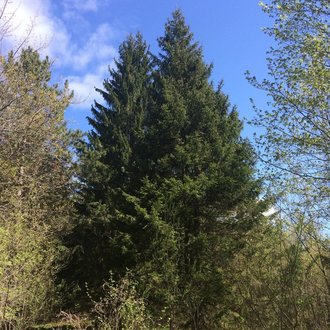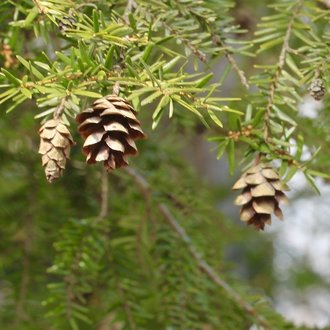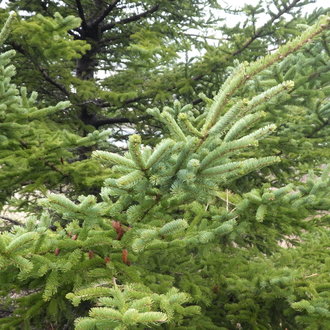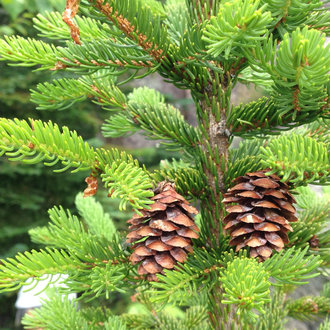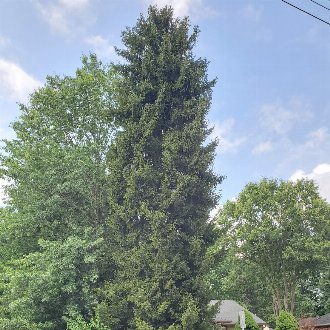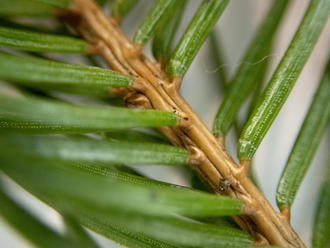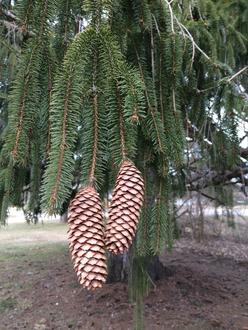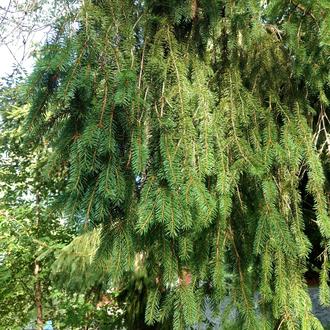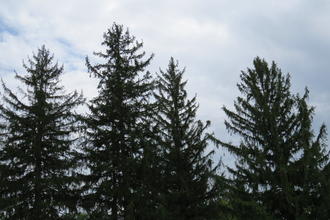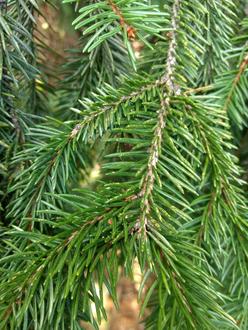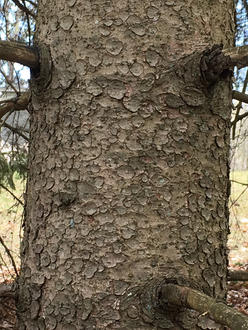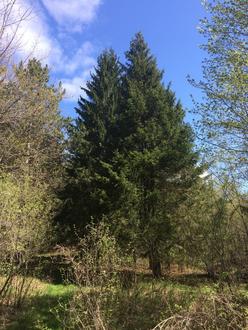Norway Spruce (Picea abies (L.) Karst.)
↑Summary
Native to Europe, and widely planted in northeastern North America, occasionally established in the wild. The spruce in North America with the widest growth habit.
↑Similar Plants
↑Habitat
Norway spruce has become established at scattered locations across North America, mostly in the northeastern US and Canada, with some in the upper Midwest and southern Appalachians, and a few locations in the mountains of the northwest. Its establishment in North America is largely a function of where it has been most widely planted, and it could likely survive in more areas.
In North America, it is mostly found in cool, moist forests, but it can survive on warmer sites than native spruces; it has successfully established in areas such as Ohio and Indiana where no native spruce occur.
Norway spruce is highly shade tolerant, and in most of its native range, it is a climax species that occupies late stages in forest succession, occurring in pure stands, mixed with other conifers, and mixed with deciduous trees as well.
The species is mostly limited to cool, humid climates, but it can survive on a wide range of soil types and under a wide range of conditions. It is tolerant of poorly-drained and waterlogged soils, and can grow in bogs, where its growth is slowed.
However, unlike the native black spruce (Picea mariana), the only native spruce growing in bogs, Norway spruce takes advantage of higher nitrogen availability in other environments and grows much faster and fuller on richer sites.
Fire-intolerant and only found on sites that have not burned regularly.
↑Life Cycle
Seedlings grow best in cool temperatures and growth is inhibited by fluctuating or consistently high temperatures. Shading may improve seedling establishment. Seedlings fare best when growing in a thick layer of organic matter, as it better holds water and decreases the risk of drought stress.
Seed production usually begins at 30-40 years of age. Good seed crops occur at very different intervals in different parts of its native range, as short as 3 years in Britain and as long as 13 years in Finland. Seeds are wind-dispersed, but usually do not travel very far. Seeds are distributed farthest when they fall onto the surface of ice-covered snow, where the wind can blow them long distances. Seeds are able to germinate immediately after falling and do not require a period of cold dormancy, but only germinate under warm conditions. Seeds do not remain viable long-term and there is no appreciable seed banking.
Trees are able to reproduce vegetatively, by layering, in which a descending branch contacts the soil and grows new roots. The drooping lower branches of this species aid the layering process. This mode of reproduction is most common in humid climates and areas with high soil moisture. Cut or damaged trees do not resprout from stumps or roots.
In its native range, trees typically remain vigorous for about 200 years, and can live 300-400 years in the far north. In North America, however, trees rarely reach 200 years of age.
↑Faunal Associations
Numerous native insects eat this species, generally ones that also eat native spruces and related conifers. These include the eastern spruce budworm (Choristoneura fumiferana) and several other moth larvae, various beetles, scales, and weevils. In general this species is much better than most non-native trees at supporting native insects.
The seeds are eaten by numerous birds, including those such as crossbills that specialize on spruce seeds. Deer usually ignore the foliage of this tree, but rabbits occasionally browse seedlings in winter.
Birds utilize this tree both for nesting and roosting; they are attracted by the dense foliage.
↑Control
This species is not widely considered invasive, although it can establish in the wild and people may want to remove it where it does, especially due to its ability to invade mature forests and hinder the growth of other vegetation beneath it.
A limiting factor in control of this species is often the ability to identify young trees, which are often confused with the native red spruce where their ranges overlap.
Trees are generally easy to kill. This species does not resprout from root or stumps, so cutting a tree off at the base kills it. Large trees with good form can be harvested for timber and sold with other spruce.
In North America, usually only scattered seedlings occur, and it usually only establishes on shady sites, where it grows slowly, so it is usually easy to stay on top of reproducing populations.
↑Uses
In North America, widely used in landscaping, where it is valued for its ease of growing, rapid growth, and tolerance of a wide range of conditions, ability to grow in warmer climates than the native spruces. It is frequently used as a windbreak.
The wood is used in construction, for furniture, and in musical instruments, as soundboards. It has a number of desirable properties, being workable, light, and soft but strong. Construction-grade wood is inexpensive, but instrument-grade wood is in short supply and often quite expensive. This species has sometimes been planted in forestry plantations.
It has also been planted in rehabilitation and reforestation projects, including on acidic mining sites, where it is valued for its tolerance of soil acidity and rapid growth.
↑Related Plants
Several other spruce species, all native, are found in North America. Of these, red spruce (Picea rubens), white spruce (Picea glauca), and black spruce (Picea mariana) are most likely to overlap in range.
↑Notes
Mature stands of Norway Spruce tend to increase the soil acidity under them over time. The combination of dense shade and soil acidity greatly inhibit the growth of plants under these trees. Both in its native range and in North America, there tends to be little undergrowth in stands of Norway spruce.
Different sources alternatively list this species as "invasive" or "not invasive".
Whether or not it is considered invasive, it clearly has the potential to establish wild populations in North America, and its shade tolerance and ability to establish in intact forests, its tendency to create undergrowth-free zones underneath it, and its ability to survive farther south than native spruce raise concerns of its potential to reduce biodiversity.
↑Links & External Resources
• Norway Spruce | The Wood Database (About This Site)
• Norway Spruce | Fire Effects Information System (FEIS) (About This Site)
• Picea abies (Norway Spruce) | Illinois Wildflowers (About This Site)
• Picea abies (Norway Spruce) | USDA PLANTS Database (About This Site)
• Picea abies | Go Botany (About This Site)
• Picea abies (Norway Spruce) | Missouri Botanical Garden Plant Finder (About This Site)
• Norway Spruce | Virginia Tech Dendrology Factsheets (About This Site)
• Picea abies | Biota of North America Project (BONAP) (About This Site)
• Picea abies | NatureServe Explorer (About This Site)
• Picea abies | Flora of North America (About This Site)
• Picea abies (L.) H. Karsten (Norway Spruce) | Digital Atlas of the Virginia Flora (About This Site)



